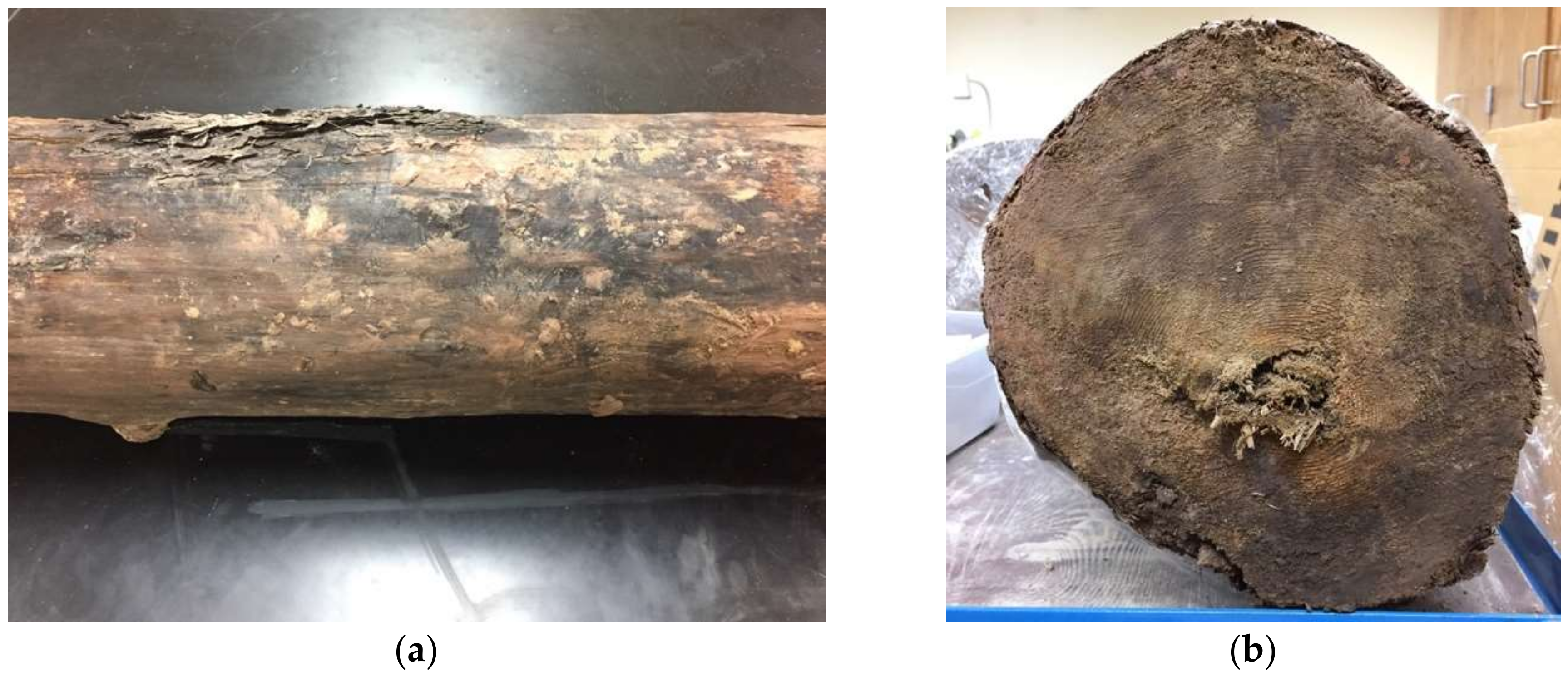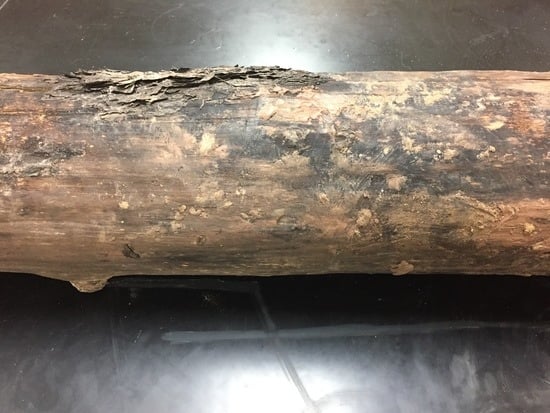Comment on “Non-Mineralized Fossil Wood” by George E. Mustoe (Geosciences, 2018)
1. Introduction
2. Discussion
3. Conclusions
Conflicts of Interest
References
- Mustoe, G.E. Non-Mineralized Fossil Wood. Geosciences 2018, 8, 223. [Google Scholar] [CrossRef]
- Web of Science Databases—Clarivate Analytics. Available online: https://clarivate.com/products/web-of-science/databases/ (accessed on 22 November 2018).
- Heine, K. Höhenstufung von Zentral-Otago (Neuseeland)—Geoökologischer Überblick. In Geoӧkologische Beziehungen Zwischen der Temperiertenzone der Sϋdhalbkugel und den Tropengebirgen; Troll, C., Lauer, W., Eds.; Erdwissenschaftliche Forschung; Steiner: Wiesbaden, Germany, 1978. [Google Scholar]
- Becker, B. Dendrochronological observations on the postglacial river aggradation in the southern part of central Europe. Biuletyn Geologiczny 1975, 19, 127–136. [Google Scholar]
- Alessio, M.; Bella, F.; Improta, S.; Belluomini, G.; Cortesi, C.; Turi, B. University of Rome Carbon-14 Dates IX. Radiocarbon 1971, 13, 395–411. [Google Scholar] [CrossRef]
- Molloy, B.P.J.; Burrows, C.J.; Cox, J.E.; Johnston, J.A.; Wardle, P. Distribution of subfossil forest remains, eastern South Island, New Zealand. N. Z. J. Bot. 1963, 1, 68–77. [Google Scholar] [CrossRef]
- Poore, M.E.D.; McVean, D.N. A new approach to Scottish mountain vegetation. J. Ecol. 1957, 45, 401–439. [Google Scholar] [CrossRef]
- Sen, J.; Barak, R.K. The Chemistry of Ancient Buried Wood. Geologiska Föreningen i Stockholm Förhandlingar 1957, 79, 737–758. [Google Scholar] [CrossRef]
- Lombardo, E. Determinazione di Alcuni Legni Subfossili Rinvenuti in Rovine di Case Romane a Ghirza (Tripolitania). Plant Biosyst. 1956, 63, 112–116. [Google Scholar] [CrossRef]
- Watt, A.S.; Jones, E.W. The Ecology of the Cairngorms: Part 1. The Environment and the Altitudinal Zonation of Vegetation. J. Ecol. 1948, 36, 283–304. [Google Scholar] [CrossRef]
- Eshuis, H.J. Palynologisch en stratigrafisch onderzoek van de Peelvenen. Mededelingen van het Botanisch Museum en Herbarium van de Rijksuniversiteit te Utrecht 1946, 94, 5–143. [Google Scholar]
- De Geer, E.H. Prehistoric Bulwark in Gotland Biochronologically Dated. Geogr. Ann. 1935, 17, 501–532. [Google Scholar]
- Broughton, A.C. Notes on the Geology of the Moorlands (South Australia) Brown Coal Deposits. Trans. R. Soc. South Aust. 1921, 45, 248–253. [Google Scholar]
- Moss, C.E.; Rankin, W.M.; Tansley, M.A. The Woodlands of England. New Phytol. 1910, 9, 113–149. [Google Scholar] [CrossRef]
- Various authors. Botany at the British Association. Nature 1901, 64, 615–619. Available online: https://www.nature.com/articles/064615a0.pdf (accessed on 5 December 2018). [CrossRef]
- Nathorst, A.G. On the geological history of the prehistoric flora of Sweden. Nature 1889, 40, 453–455. [Google Scholar] [CrossRef]
- Pallardy, S. Physiology of Woody Plants, 3rd ed.; Academic Press (Elsevier): Burlington, MA, USA, 2008; 453p, ISBN 978-0120887651. [Google Scholar]
- Panshin, A.J.; De Zeeuw, C. Textbook of Wood Technology, 4th ed.; McGraw-Hill Inc.: New York, NY, USA, 1980; 723p, ISBN 9780070484412. [Google Scholar]
- Rowell, R.M.; Pettersen, R.; Tshabalala, M.A. Cell wall chemistry. In Handbook of Wood Chemistry and Wood Composites; Rowell, R.M., Ed.; CRC Press, Taylor & Francis Group: Boca Raton, FL, USA, 2013; pp. 34–72. ISBN 9781439853801. [Google Scholar]
- O’Neill, M.A.; Wyork, W.S. Chapter 1. The composition and structure of plant primary cell walls. In The Plant Cell Wall; Rose, J.K.C., Ed.; Blackwell Publishing, CRC Press: Oxford, UK, 2003; pp. 1–54. ISBN 1-84127-328-7. [Google Scholar]
- Basinger, J.F.; Greenwood, D.R.; Sweda, T. Early Tertiary Vegetation of Arctic Canada and its Relevance to Palaeoclimatic Interpretation. In Cenozoic Plants and Climates of the Arctic; Boulter, M.C., Fisher, H.C., Eds.; Springer: Berlin, Germany, 1994; pp. 175–198. [Google Scholar]
- McIver, E.E.; Basinger, J.F. Early tertiary floral evolution in the Canadian High Arctic. Ann. Mo. Bot. Gard. 1999, 86, 523–545. [Google Scholar] [CrossRef]
- Harrington, G.J.; Eberle, J.; LePage, B.A.; Dawson, M.; Hutchison, J.H. Arctic plant diversity in the early Eocene greenhouse. Proc. R. Soc. 2012, 1515–1521. [Google Scholar] [CrossRef] [PubMed]
- Poole, I. Fossil angiosperm wood: Its role in the reconstruction of biodiversity and palaeoenvironment. Bot. J. Linn. Soc. 2000, 134, 361–381. [Google Scholar] [CrossRef]
- Bigras, F.J.; Colombo, S.J. (Eds.) Conifer Cold Hardiness; Springer: New York, NY, USA, 2001; 596p, ISBN 978-94-015-9650-3. [Google Scholar]
- Matthews, J.V., Jr.; Ovenden, L.E. Late Tertiary Plant Macrofossils from Localities in Arctic/Subarctic North America: A Review of the Data. Arctic 1990, 43, 364–392. [Google Scholar] [CrossRef]
- Fletcher, T.; Feng, R.; Telka, A.; Matthews, J.V., Jr.; Ballantyne, A. Floral dissimilarity and the influence of climate in the Pliocene High Arctic: Biotic and abiotic influences on five sites on the Canadian Arctic Archipelago. Front. Ecol. Evol. 2017, 5. [Google Scholar] [CrossRef]
- Davies, N.S.; Gosse, J.C.; Rybczynski, N. Cross-bedded woody debris from a Pliocene forested rivers system in the High Arctic Beaufort Formation, Meighen Island, Canada. J. Sediment. Res. 2014, 84, 19–25. [Google Scholar] [CrossRef]
- Fyles, J.G. High terrace sediments, probably of Neogene age, west-central Ellesmere Island, Northwest Territories. In Current Research Part D, Interior Plains and Arctic Canada (No Editor Listed); Geological Survey of Canada Paper 89-1D; Canadian Government Publishing Centre: Ottawa, ON, Canada, 1989; pp. 101–104. [Google Scholar]
- Ballantyne, A.P.; Rybczynski, N.; Baker, P.A.; Harrington, C.R.; White, D. Pliocene Arctic temperature constraints from the growth rings and isotopic composition of fossil larch. Palaeogeogr. Palaeoclimatol. Palaeoecol. 2006, 242, 188–200. [Google Scholar] [CrossRef]
- Ballantyne, A.P.; Greenwood, D.R.; Sinnighe-Damsté, J.S.; Csank, A.Z.; Eberle, J.J.; Rybczynski, N. Significantly higher Arctic surface temperatures during the Pliocene indicated by multiple independent proxies. Geology 2010, 38, 603–606. [Google Scholar] [CrossRef]
- Csank, A.Z.; Patterson, W.P.; Eglington, B.M.; Rybczynski, N.; Basinger, J.F. Climate variability in the early Pliocene Arctic: Annually resolved evidence from stable isotope values of sub-fossil wood, Ellesmere Island, Canada. Palaeogeogr. Palaeoclimatol. Palaeoecol. 2011, 308, 339–349. [Google Scholar] [CrossRef]
- Rybczynski, N. Woodcutting behavior in beavers (Castoridae, Rodentia): Estimating ecological performance in a modern and a fossil taxon. Paleobiology 2008, 34, 389–402. [Google Scholar] [CrossRef]
- Tozer, E.T. Geological reconnaissance Prince Patrick, Eglinton and western Melville Islands, Arctic Archipelago, Northwest Territories. In Geological Survey of Canada Paper 55-5; Canadian Government Publishing Centre: Ottawa, ON, Canada, 1956; p. 32. [Google Scholar]
- Fyles, J.G. Beaufort formation (late Tertiary) as seen from Prince Patrick Island, Arctic Canada. Arctic 1990, 43, 393–403. [Google Scholar] [CrossRef]
- Devaney, J.R. Clastic sedimentology of the Beaufort Formation, Prince Patrick Island, Canadian Arctic Islands: Late Tertiary sandy braided river deposits with woody detritus beds. Arctic 1991, 44, 206–216. [Google Scholar] [CrossRef]
- Jahren, A.H. The Arctic forest of the middle Eocene. Annu. Rev. Earth Planet. Sci. 2007, 35, 509–540. [Google Scholar] [CrossRef]
- Heer, O. Die Fossile Flora der Polarländer; Druck und Verlag von Friedrich Schulthess: Zurich, Switzerland, 1868; p. 192. Available online: https://www.e-rara.ch/zut/content/titleinfo/3126379 (accessed on 5 December 2018).
- Jahren, A.H.; Sternberg, L.S.L. Humidity evidence for the middle Eocene Arctic rain forest. Geology 2003, 31, 463–466. [Google Scholar] [CrossRef]
- Jahren, A.H.; Byrne, M.C.; Graham, H.V.; Sternberg, L.S.L.; Summons, R.E. The environmental water of the middle Eocene Arctic: Evidence from δD, δ18O and δ13C within specific compounds. Palaeogeogr. Palaeoclimatol. Palaeoecol. 2009, 271, 96–103. [Google Scholar] [CrossRef]
- Hooyer, T.S.; Mickelson, D.M. Stop 5: Two Creeks forest bed, Ebben Quarry, Brown County. In Late Glacial History of East-Central Wisconsin; Survey Open-File Report 2007-1; Hooyer, T.S., Ed.; Wisconsin Geological and Natural History: Madison, WI, USA, 2007; pp. 72–87. [Google Scholar]
- Rapp, G.; Hill, C.L. Geoarchaeology: The Earth-Science Approach to Archaeological Interpretation, 2nd ed.; Yale University Press: New Haven, CT, USA, 2006; p. 368. ISBN 978-0300109665. [Google Scholar]
- Mickelson, D.M.; Hooyer, T.S.; Soch, B.J.; Winguth, C. Late Glacial ice advances and vegetation changes in east-central Wisconsin. In Late Glacial History of East-Central Wisconsin; Survey Open-File Report 2007-1; Hooyer, T.S., Ed.; Wisconsin Geological and Natural History: Madison, WI, USA, 2007; pp. 72–87. [Google Scholar]
- University of Arizona Laboratory of Tree Ring Research. Great Lakes Network of Fossil Tree Rings. Available online: https://greatlakes.ltrr.arizona.edu (accessed on 29 August 2018).
- Panyushkina, I.P.; Leavitt, S.W.; Mode, W.N. A long Bølling-Allerød tree-ring record from the U.S. Great Lakes. Tree-Ring Res. 2017, 73, 102–112. [Google Scholar] [CrossRef]
- Fyles, J.G.; Hills, L.V.; Matthews, J.V., Jr.; Barendregt, R.; Baker, J.; Irving, E.; Jette, H. Ballast Brook and Beaufort Formations (Late Tertiary) on northern Banks Island, Arctic Canada. Quat. Int. 1994, 22–23, 141–171. [Google Scholar] [CrossRef]

| Year | Authors | Description |
|---|---|---|
| 1978 | Heine [3] | Höhenstufung von Zentral-Otago (Neuseeland)—Geoökologischer Überblick; “Subfossile Baumreste wurden darin häufig gefunden.” [Subfossil tree remains were often found in it.] (‘subfossil’ used 4 times) |
| 1975 | Becker [4] | Dendrochronological observations on the postglacial river aggradation in the southern part of central Europe; “[…] Figure 6 [gives] a complication of all published C14-datings made from subfossil wood pieces found in postglacial gravel terraces of Central European rivers.” |
| 1971 | Alessio et al. [5] | University of Rome Carbon-14 Dates IX; “Wood, subfossil stumps and trunks, found in situ, Mezzano salt valley” |
| 1963 | Molloy et al. [6] | New Zealand Journal of Botany; Distribution of subfossil forest remains, eastern South Island, New Zealand. |
| 1957 | Poore and McVean [7] | A New Approach to Scottish Mountain Vegetation; “Sub-fossil stems of dwarf juniper are often exposed...” |
| 1957 | Sen and Barak [8] | The Chemistry of Ancient Buried Wood; “It has been found that the amount of both cellulose and lignin is more in the inner fresh-looking portion of a subfossil elm wood as compared to the normal sample.” |
| 1956 | Lombardo [9] | Determinazione di Alcuni Legni Subfossili Rinvenuti in Rovine di Case Romane a Ghirza (Tripolitania); [Determination of Some Subfossil Woods Found in Ruins of Roman Houses in Ghirza] |
| 1948 | Watt and Jones [10] | The Ecology of the Cairngorms: Part 1; “In the series of papers by Lewis subfossil pine is stated to occur at various maximum altitudes …” |
| 1946 | Eshuis [11] | Palynologisch en stratigrafisch onderzoek van de Peelvenen; “The 1st, 2nd and 4th beam in the foreground of the shed in photo 5 has been sawn from a 30 m long subfossil pine.” |
| 1935 | De Geer [12] | Prehistoric Bulwark in Gotland Biochronologically Dated; “This investigation has shown that subfossil Pinus stocks may be good climatic indicators in teleconnection”, “we may by these graphs of subfossil prehistoric tree rings follow their correspondence to Douglass’ sequoia record directly by graphic comparison.” |
| 1921 | Broughton [13] | Notes on the Geology of the Moorlands (South Australia) Brown Coal Deposits; “These subfossil trees occur generally in a horizontal position within the enveloping carbonaceous matrix.” |
| 1910 | Moss et al. [14] | The Woodlands of England; “In the course of time, as a result probably of decreasing aeration of the soil, the marshy vegetation gains the upper hand: the former woodland becomes submerged and leaves only a sub-fossil tree-layer in the peat of the newly formed moor.” |
| 1901 | Various [15] 1 | Yew tree distribution; “The evidence was derived from the microscopical examination of subfossil wood …” |
| 1889 | Nathorst [16] | On the Geological History of the Prehistoric Flora of Sweden; “in West Nyland, in Finland, sub-fossil remains of spruce in a stratum which he estimates to be older than the remains of spruce found in Scandinavia.” |
© 2018 by the authors. Licensee MDPI, Basel, Switzerland. This article is an open access article distributed under the terms and conditions of the Creative Commons Attribution (CC BY) license (http://creativecommons.org/licenses/by/4.0/).
Share and Cite
Luczaj, J.A.; Leavitt, S.W.; Csank, A.Z.; Panyushkina, I.P.; Wright, W.E. Comment on “Non-Mineralized Fossil Wood” by George E. Mustoe (Geosciences, 2018). Geosciences 2018, 8, 462. https://doi.org/10.3390/geosciences8120462
Luczaj JA, Leavitt SW, Csank AZ, Panyushkina IP, Wright WE. Comment on “Non-Mineralized Fossil Wood” by George E. Mustoe (Geosciences, 2018). Geosciences. 2018; 8(12):462. https://doi.org/10.3390/geosciences8120462
Chicago/Turabian StyleLuczaj, John A., Steven W. Leavitt, Adam Z. Csank, Irina P. Panyushkina, and William E. Wright. 2018. "Comment on “Non-Mineralized Fossil Wood” by George E. Mustoe (Geosciences, 2018)" Geosciences 8, no. 12: 462. https://doi.org/10.3390/geosciences8120462
APA StyleLuczaj, J. A., Leavitt, S. W., Csank, A. Z., Panyushkina, I. P., & Wright, W. E. (2018). Comment on “Non-Mineralized Fossil Wood” by George E. Mustoe (Geosciences, 2018). Geosciences, 8(12), 462. https://doi.org/10.3390/geosciences8120462







